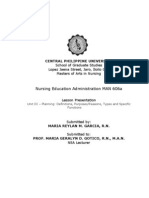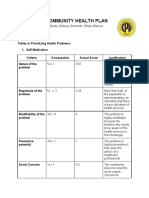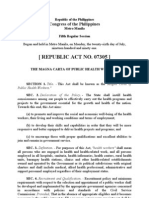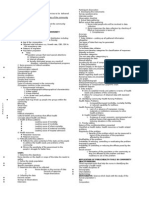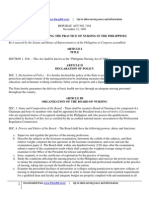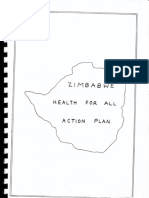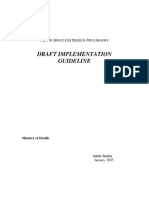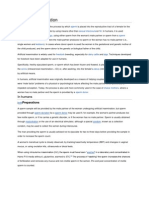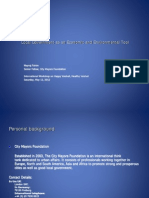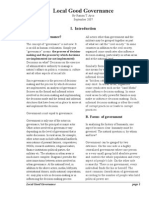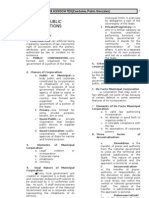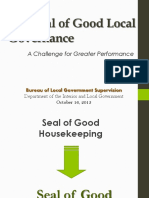APBHP
APBHP
Uploaded by
Donna Lei G. RosarioCopyright:
Available Formats
APBHP
APBHP
Uploaded by
Donna Lei G. RosarioCopyright
Available Formats
Share this document
Did you find this document useful?
Is this content inappropriate?
Copyright:
Available Formats
APBHP
APBHP
Uploaded by
Donna Lei G. RosarioCopyright:
Available Formats
Monograph No.
Area/Program
Based Health Planning in the Philippines
Monograph No. 2
Area/ProgramBased Health Planning in the Philippines
By Steven L Solter, I.D., I%1. I.
Management Sciences for Iea Ith
Area/Program-Based Health Planning in the Philippines CSP Monograph No. 2
Published by The Child Survival Program, Department of Health, Republic of the Philippines, with the as-istance of the United States Agency for International Development (USAID). Manila 1993
Editing, design and production by Beaulah 1'.Taguiwalo
Area/Progratn-Based Ifl'alth Planning in the Philippines
Contents
Page 7 Page9 Page 11 Page 12 Page 16 List of acronyns used Executive Summary 1 2 3 Introduction What is APBHP? Advantages and disadvantagesof APBHP in the Philippineexperience Lessons learned fron the Philippine experience with health planning The impact of APBHP at the local level The sustainabilityof APBHP in the Philippines "Next steps" for APBHP in the Philippines Conclusion
Page 18
Page20 Page25
5 6
Page27
Page28 Page29
Appendix A Selected APBHP Worksheets Appendix B Checklistfor a "quality" plan
Page37
Area/Prograin-Based Heilth Planning in the Philippines
List of acronyms used
APBIIP BHS DOEPlI FHSIS FIC IPS LGC LGL MHO MOOE NGO P110 RHU RITM USAID Area/ Program-Based H alth Planning Barangay Health Station Department of Health Expanded Program on Immunization Field Health Services Information System Fully Immunized Child Internal Planning Service Local Government Code Local Government Unit Municipal I lealth Officer Maintenance and Other Operating Expenses Non-Government Organization Provincial Ilealth Officer Rural I lealth Unit Research Institute for Tropical Medicine United States Agency for International Development
Aea/Prograin-Basedthalth Planning in the Philippine,
Executive Summary
I N AYH LT TAION
Beginning in 1989 the
Philippine Department of Ilealth (DOH) developeJ a new approach to health planning as a key element in its Child Survival Program. Knovn as "Area / Program-Based I lealth Planning" (AIPB IP), its main features include the following: * It is decentralized in that midwives and nurses from Barangay I fealth Stations (1I IS)and Rural I Iealth Units (RI IU) actively participate in the planning process. * It is data-based, relying l the Field Iealth Services Information System (1t ISIS) to provide the most important inputs. o It targets particular geographic units, such as barangays, which have low levels of coverage foc key programs. o It also targets particular programs which are performing poorly in a number of barangays. It can be said without e\aggeration that AI'Ht 11'revollutioniied health planning in the Philippilnts. An AIl I P Manual (now in its 4th edition) has been widely disseminated aad health workers at all levels have been trained in the AI'HI 1i approach. Annual plans meeting qualityV standards are produced by all 75 provinces and ho chartered cities. The APHI I methodology anticipated the fact that health services in the Philippines would be devolved to Local Government Units (LGU). In
Area/Programn-BasedHealth Planning in the Philippines
addition, augmentation funding is made available to provinces and cities to implement their health plans on a decentralized basis. The sLICCCSS of the Area/Program-Based Health Planning approach can be explained by a number,4 factors, including strong leadership from top management of the DOI i, continued funding from and close collaboration with the principal donor - USAID, and the commitment to develop and use a powerful p!anning tool on the part of thousands of midwives, nurses, and doctors throughout the country. But APBHP in the Philippines has had its share of setbacks and problems; i, has not been an unmitigated success. The problems in implementation have included: APBUIP is very time-consuming for midwives to do every year, given all of their other responsibilities. e Actual copies of local health plans have often not beeni available to implementors. * Augmentation funds from the Central Office often arrive in the provines very late in the calendar year. What lessons have been learned from this experience? 1. A clear, focused health plan with measurable/feasible targets makes everyone's job easier - front-line health worker, supervisor, and program manager. 2. In order to develop a sustainable, institutionalized approach to health planning (which replaces the previous system), a comprehensive long-term strategy is required. There is no quick fix. 3. Leadership is required from senior management to help generate the momentum required by the adoption of a new planning methodology. 4. When a health system decentralizes, a new health planning approach must meet the needs of both health workers and local government officials.
10
Area/Pr,,'ratn-Based Healli Planningin the Philippines
Introduction
Health planning is an art as well as a science, and often, there is a wide gap between the content of health plans - what is supposed to happen and tile execution - what actually does happen. For one thing, health planners work with incomplete and frequently inaccurate data, and they rarely know with any precision what sort of health budget will be available for the period being planned. Furthermore, the unexpected always happens - be it a political change, an epidemic, or some natural disaster - so that implementation of planned health programs varies, sometimes radically, from what had been anticipated. Given this gap between plan and execution, it has been observed that what really counts is not the plan itself but the process that planners go through in creating the plan. As health planners go through the steps of creating a plan, they inevitably learn a great deal about priorities and about the obstacles to improving the health status of the population. With the collapse of centralized, planned economies throughout the world and the trend towards rapid decentralization and devolution, what is the status of planning in the Philippines and that of health planning in particular? Beginning in 1989 the Philippines' Department of Health (DOH) undertook an entirely new approach to health planning - quite different from anything that had ever been done before in the Philippines, and distinct from the planning approaches developed by most other countries. What was this unique Philippine way of doing health planning? What has been the Filipino experience with this new planning methodology and what lessons can be learned from it? This paper will try to answer these questions.
11
Area/Pr,,Vrain-BasedHealth Planning in It Philippines
What is APBHP?
GOARESOUCC
A rea/Program-Based Health Planning was developed, beginning in 1989, to meet a need. For many years in the Philippines' DOH, health plans had been formulated by provinces, but not on a regular basis, and only province-level staff yere involved in most cases. The usual practice was for provincial health staff to develop operational plans for each of their health programs, without involving local health workers at the district or municipal levels. These plans were "optional" and were not regularly submitted for approval to regional or central levels. The plans were usually quite general, were not data-based, and did not clearly identify which geographical areas had low coverage levels or which programs were performing poorly in a large number of barangays. By 1989 it had become abundantly clear to health managers in the DOH that the existing health planning methodology was not meeting the needs of health workers at every level. 0 At the Barangay and Municipality levels, health workers were not involved in health planning at all, and possessed no tools that would enable them to identify particular programs or particular barangays needing special attention. * At the Province level, health plans were dutifully written but were based on last year's plan rather than being "data-based".
12
Area/Prograin-Based I l'alth Planningin tet Philippines
* At the Regional and Central levels, health plans were not nearly as focused or targeted as they should have been, and as a result were not good "road maps" for determining appropriate strategies for getting where they needed to go. An important idea behind Area/Program-Based Health Planning was the empowerment of health workers at the local level - including midwives, nurses, and doctois -- by enabling them to make health plans based on their own local priorities. In particular, the methodology developed for Area/Prograni-Based Health Planning (APBt IP) provided a means whereby a midwife could determine which barangays in her catchment area had low coverage levels for major problems - and thus needed more time and effort on her part to raise coverage levels - and which barangays had relatively high coverage levels - thereby needing less of her attention. In addition, the APBH1P methodology allowed the midwife -and other health workers to determine which health programs were performing poorly in a number of barangays, thus indicating which programs needed priority attention. It should now be clear why this planning approach is indeed "aiea/program based". It is area-based in that each geographical unit -- usually the barangay -- is assessed according to how well health programs are p'rforming in that particular area. It is program-basd in that each program is examined according to how it is performing in a number of barangays. APBH P is not limited to identifying priority programs and geographical in its. 'The methodology includes a sequlence Of steps that alloVs the planner
to identity the main cotwtraint ,
to effective health service del verv and to determine what cin h done to eliminate those clInstiints. The word "plai'mer" includes midwvivyes, s pervillng public health ,onrses, and doctors a the municipality and provinlcial levels. Ilh' major function of planners at h~ivler levels (rtegional and national) is to consolidate plans from lower The major steps in this proLcess can b.' sumniarized as tolhn\ws: l-i 1. Problem Analysis. I his involves using selected program parameters to as,,ss and analyze' perforrmmnce or lack of perfo, ,l'ance. For example, for the N 1:F mnded l'rgram on Immunization (ITl), a proviicial health officer may h, o se the parameter "ully Immunized ('1iild" or HC, llleanlg the p'ceritage oAchildren on their first birthday who ,re fully immunized With the six ( ) [11 antigens. 'Ili plamner then determines a "cut-off point" below which progranil performance is considered u isati.factorv. A typical cut-off . Tbis ineais that any geographical unit - po int for the FIC parameter is 8 tic as a baranga, --- with an FIC below 85'/ woUld be considered a poorly ,. 13
Area/J'rograin-BasedHealth Planningin the Philippines
performing area needing additional attention and resources. When performance is consistently below the cut-off point in a number of areas, the planner determines the causes of the inadequate performance or low coverage. Each province chooses its own parameters and cut-off points, which are applied consistently throughout the province. 2. Goal Setting. The provincial planner decides on targets or goals for
each health program being implemented and for each activity needed to
achieve program targets. For EPI, for example, the provincial target is set
higher than the cut-off point. For the FIC parameter, where the cut-off point
was 85'; , the planner may choose a target or goal of say, 0';O.
3. Formulation of Measures. The nlanner identifies the most important
measures necessary and sufficient to achieve the targets or goals specified
for each program. These measures can come from program guidelines,
usually issued bV the Central Office in Manila, or from tile planners' own
imagination and insight. Measures are normally selected at tile municipality
level.
4. Activity P'lanning. The municipality-level planner as well as barangay-based miwives decide what activities and tasks are required to
carry out the neces',arv measures that have alreadv been decided.
These
activities and tasks are assigned to individuals so that clear lines of
responsibility are drawn.
5. Resource Planning. The planner, such as the Provincial Ilealth Officer or '1 compLtes, estimates, consolidates, and summarizes the personnel, 10, logistical, financial and other resource requirements needed to perform all tile requisite activities .id tasks. In order to make these steps easier for the planner to accomplish, the Internal Planning Service (I1i'S) of the DOt I Central Office in Manila has written and distributed a set of guidelines entitled, "Area / Progran-Based I ealth l'lanning Manual'. This comprehensive guide includes worksheets which make it relatively easy for those developing health plans to follow the steps, identify programs and geographical areas needing particular attention, as well as identify the goals, measures, and activities needed to remedy the situation. Selected worksheets taken from the APBI tP Manual are included at the end of this paper. (See Appendix A.) The sequence of planning ste ,s is initially carried out by the midwife, and tile area covered is her Barangay I-ealth Station (HI-IS) ca-liment area. At tile Rural Health !'ait (RI IU), the doctor and public health nurse consolidate the plans of the different BHI-IS catchment areas into a single municipality health plan. Municipality plans are further consolidated at the district level, and 14
Area/Program-BasedHealth lla nnipg in the Philippines
district plans are in ti rn consolidated at the province level. The objective of this series of consolidations is to eliminate redundancy and overlap, and to produce consolidated plans that are easy to use and that reflect a coordinated approach so that resources are used as efficiently as possible. This development of the APBHP approach occurred over a two-year period, involving senior management in the DOHl, especially the Chief of Staff; outside consultants; as well as active involvement of the DOH at all levels, from the Internal Planning Service to BHS midwives. Tile APBHP methodology was field-tested in Quezon province in 1990, and based on that experience the Manual was developed (now in its 4th revised edition). A series of workshops was held throughout the country so that health workers could be trained in the APBHP approach. By 1992 nearly every health worker in the country had experience with APBHIP and were using it to raise coverage levels and increase the impact of such programs as EPIl, the Control of Diarrheal Disease, tle Control of Acute Respiratory Infections, Maternal Care, Family Planning and Nutrition.
15
,1/
Area/Proram-BasetdHealth Phnnin in flit Philippines
Advantages and disadvantages of APBHP in the Philippine experience
W' T ell oneC compares
AlBI I' a practiced in the I'hlilippine's si nce IL -m)withI health planning ais (;cturred in the country it before l9)L(), or with how health planninig is conducted in other conntrie , k rtain advalntages aid disadva ntagt, em nerI Thest'a vantage', n1d disal i v,11,,S (it the APBI I'approach can ,he divided into two categories: those that relate to its planning methodology Or it,; conceptual aspects and those that relate to its actual implementatiol. Advantages ot the AI'M I methodology: I' I. APBI 1P represents utu ]approach for devolved health units, such as municipalities, which can he applied to other sectors besides heaPh. Agriculture, for example, can use the area/program ba.,ud approach b, identifying which baramga vs have how rice yields and which igriculturA programs are performinig p ,orly in a large number of barangays. Maryors may also( find the approach hlliHI. 2. [he methodology of A. IOf I' reqiu i res inter-sectoralI collaboration, I including involvemenrt of other government organizations, NGOs, and the private sector. Shuch close cooperation at the local level is essential for effective service delivery, especially in the era of devolution.
16
Area/Prgrami-Base,I halth Plan iibi in
it
'lhilipt,iIes
Advantages of the APBHP approach based on actual implementation: 1.There is active involvement in health planning at all levels of tile system, from midwives up to provincial and regional staff. 2. At this point, 1993, there has been three years worth of experience with APII'. Familiarity with how API3t 1I' orks is widespread among health w workers; a readable manual exists ISan aid to plan preparation; most midwives, nurses, and doctors, both in the field and in the Central Office, are supportive. 3. AI131Il1' has been effective as a m1ean1s Of identifying weak areas and programs and in strengthening them. Disadvantages of the AlPBt 11' ethodology: m I.
AI'11 ) approach is very time-consuminig, especially for midwives The who must obtain detailed coverage data for every health program in each of the barangays in their catchment areas. This data-collecting can take two weeks of full-time work and is repeated every y'ear. 2. The plannin,,'guidelines do not place a limit on tile lvel Iof funding for the plans made by local health staff. As a result, the total resources required to imnplement the plans at different levels often far exceeds the resources actually available. This in turn leads to frustration since many'it most not plan activities can never be carried o)ut. 0ftten, the plans simply represent a fantas o(f what heaIlt h officials would like to happen rather than a feasible set of tasks that can actually be accomplishcd. Disadvantages of tie APBI 11 approach based on actual implementation: 1.In actual practice, few midwives, nurses, or rural health physicians have access to a copy of their hlal plan, once the annual plans arc su~blitted. They eilher have to depend on an occasional visit to tile Provincial I lea th ()fficC where copies of tile plans are available, or end up implementing their plan based on memory. 2. "1 Iere haVe been difficul ties in the distribution of finds to enable the provinces to implemlent their plans. Mainly because of tilelowness ill s the "oVernmLent's budgct approval process, dono11r fnids made available from the Central Ot ice ill anilIa to augment Ilhilippi ne goVernment funds often arrive in NoTInlbr or December in the provinIces. While augnentation tunds are su[pposed to be spent by December 31 of each calendar year, it is actuallv poss;At,to roll over unspent dlmor funds to tileext calendil year. n Ilowever, mawy provincial health offices do not know how to do this in practice and instead, they return unspent funds to the treasury.
17
/.
Area/Prosramn-Basedth'alth Planningin the Philippi's
Lessons learned from the Philippine experience with health planning
Several lessons have been learned from the Philippine experience in health planning which are relevant to other countries. Four of these lessons seem of particular significance: 1. A clear, focused health plan with measurable/feasibh, tarets makes
everyone's job easier -- front-line health
worker, supervisor, and program manager. Although in the Philippines there is sometimes a tendency to focus too much on achieving targets - that is, focusing just on the numbers - with not enough emphasis on the means of reaching them, there is definite value in defining measurable/feasible objectives. As a result of setting qluantifiable, clearly defined targets, health workers at all levels are able to determine how well they are doing and whether they need to change their
operational strategy to do better. The targets enable health workers, including the midwives, to asse,,s their own performance as they go along,
and this is invaluable. Now that health services in the Philippines are being devolved to local government units, the experience of APB-P at the local level will make it relatively easy for midwives and nurses to make their own municipality health plans, based on their own data, with meaningful targets. A basic
18
-/
Area/Program-Based Health Plvnning in the Philiplpines
lesson is this: as the nations of tile world increasingly decentralize the management of services, tile importance of local capability in planning and managing those services will become geater and greater. 2. In order to develop and install a new and sustainable, institutionalized approach to health planning, a comprehensive long-term strategy is required. There is no quick fix. It is tempting to simplify health planning to the point where health staff can do it in a spontaneous, rapid way. But if a totally different and more systematic approach to planning is desired, there must be a comprehensive long-term strategy to implement it, including training, manual development, supervision, regular feedback, monitoring, and technical assista.ce as needed. Appendix B contains a checklist developed by the Internal Planning Service (llS) of the DOll, based in Manila, which aiiows planners to determine if they are including all the elements of a "quality' plan. 3. Leadershipis requiredfrom senior management to help generate the momentum required by the adoption of a new planning methodology. In most ministries of health around the world, health planning approaches are typically a habit of long-standing on the part of health staff, and old habits die hard. To overcome inertia and resistance to change, strong support from top management is e:ssential. Support from management, however, is by itself not sufficient for ensuring the adoption and effectiveness of a new approach; the new approach itself must be useful to health staff in the first place and must meet their needs. 4. ;When a health system decentralizes, a new health planning approach must leei he 'needsof both health Workers and local goVertnent officials. A devolved health system, such as the Philippines has introduced in 1993, means that health workers at the lotal level are no longer employed by the national Department of I lealth but instead are responsible to local politicians -- mayors and g, 'ernors. A new health planning approach mav meet the needs of local health workers but may be unacceptable to local government officials. For example, an elaborate planning Methodology, which is time-consuming, mav alienate the local mayor who mnv receive complaints that the midwife is too busy planning to be able to see patients. Under such circumstances, a simplified approach may be necessary.
19
,
j
Area/Program-Based Health Planninp in the Philippines
The impact of APBHP at the local level
What happened in
Quezon province?
Thle experience of Quezon
province regarding API3lP is
unique because it was the first province to use the new planning
methodology. AlIl3 Ilwas "field-tested" in Quezon in late 198-) before it was tried
otW in the reSt of the countrv. Why was Quezon
ch oen to he first ? Jooking at the map gives us tile
aiaswer -- Q11ie.,on is not too far from Metro Manila,
ab.',it to th ree h 1u drive, thus allowing easy access
rs' 1 tor careful observation. Also, QneIoM's geograply includes island
nuinicpalitie-, ilonu coastline, remote mountain areas, and areas with
':, and order" problems -- a true microcosm of the Philippines. I, ,dhition, ()uezon was kiown for its itnovative programs in health service (lc0i\VrV, ';och as tie Iondoc leninsula I lealth Project, which was begun in In L)c e niber I
gI()
L
including ,lalhe Nhmicipal I lealth (0)16fers and a number ot provincial level t staft, were trained in the A!I i ) methodologv in a 3-day workshop at the I articipants all seem to recall the sa me three things from that workshop:
Re'ea rch Institute for Tropical Medicine (RIlM), located near Manila.
al)N it forty participants from Qtezon province,
Area/Program-Basedflealth Planningin the Philippines
9 The APBHP approach was at first confusing because it was so different
from the approach that they were used to.
* By the end of the second day, the APBHP approach was much clearer, after they had practiced the methodology by going through it step-by-step. * Tile third day was disrupted by an attempted, coup which took place quite near the RITM bt which failed to overthrow the Aquino government.
A brief follow-up training session took place in Quezon province in February 1990. Midwives and nurses from tile different municipalities of the province were trained and were then asked to prepare a health plan for 1991. This is something they had never been asked to do before. Previously, the midwives a,'d nurses had been given targets to achieve; these targets were based on a formula originating from the DOH in Manila. ihe targets were for specific programs for each municipality, and there was no targeting whiatsoever at the barangay level. Now, in early 1990, they were being asked to prepare a complete plan for their municipality, other than hospital-based
activities. They had to review their data for each barangay and determine which of the 4 or 5 barangays in their catchment area had low coverage
levels for important programs, and vhich programs were performing poorly in most of their barangays. This would allow them to identify barangays and r1rograms needing special attention, so that the midwives would be able to prioritize their time and their use of resources. li addition, this new plan rcquired an analysis of their goals, tile constraints that they faced, and how
these constraints could he overcome. It was a daunting task, but the mlid wives had no choice Iu t to make the plan. Loo king hick on those days in earlv I99, tile I idwives now remember hMwv hard the worked and how muCh their husbands complained. Some of the hushands, apparently, ,,ere suspicious of thi]r wives' explanation that mamy late nights in a row,,X\ ere required for pre-paring a plan. Solme huhalnds even si ispected that thieSe Iatr' Iights were occUpying their spouses for v t another pu 'pisO a ItOge' >er... Hit somiehow, affer 2 to I weeks porin'g over their re,ister hooks and '.a ~get-cliet fists, the midwives were finally abhle to generate the data needed to th m unici pality plans. Now%' t ire haton was passed to the supervising p;I!ic health tnutrI'Ss the Mnicipal Ilhaltil fficer, usually a docior, who and 1 O nIeeded f take the idra a,- and progra m-speci fic data and prodtLC a nuoimicip'ilit' plln for 1I. "This was also nev for tiem, but they managed to do it. Tht ne\t step was for all of the municipality plans to sonlehow be "consolidated" into a single provincial health plan. Making annual plans
21
Area/Program-Based Health Planning in the Philippines
was not new for the Quezon provincial health staff. For years they had been producing plans, but they had been fairly simple and did not require aly data from thle barangay or even municipality levels. All they had needed to do was to write a brief "situational analysis', compute their targets for specific health programs based on formulas from Manila, and estimate their budgetary requirements for achieving their targets - usually last year's budget plus 10. ;. Although Quezon provincial health staff had involved Municipal Health Officers (MHOs) since 1984 in their health plans, the requirements for the AIPBI-lP approach were far greater than what they were used to. It had to be a team effort and it needed the involvement of people outside of DOt t, such as individuals working for NGOs and local government officials. According to Quezon province health staff, the 1991 AP3I-l Plan represented a revolutionary change not only inthe way they planned but also in the way they managed health programs. For example, urder the "old" system, most mayors thought of health programs as synonymous with hospitals and "medical missions" - that is, sending out medical teams to rural areas to give out free medicines. With API3 IP,the mayors in Quezon began to understand that health involved much more than hospitals and missions; likewise, NGOs began to see health services provided by the DOlH as being more 'developnent-oriented'" than had been true in the past. Given this very positive experience, what were the main difficulties encountered in Quezon Province in developing the AIBHP approach? * The process was very time-consu ming, especially for midwives and nurses, as compared with health planning in the past. An opportunity cost was also involved -- the time devoted by midwives to health planning was
time taken away from seeing and attenlding to mothers and children or
implementing public health programs. * Because the AI'Bt 11methodology places no limits on the amount of money or resources that can be requested as part of the plan, Quezon's provincial health plan requested far more than was actually available. This led to some frustration since the approved plans required a great deal of scaling back to adjust to the resources that are actually available. Quezon health staff would have preferred to have been told the approximate amount of funds available prior to working on their plan. * The other source of frustration for health officials in Quezon was the fact that augmentation funds for implementing their plan came very late in the year to be of much use.This problem was not due to the APBI-IP methodology, however, but rather to bureaucratic delays within the Philippine government system. 22
Area/Program-BasedHealth Platin
in the Philippines
What will happen to APBHP in Quezon now that the DOH has devolved health services to the local level? 1. Quezon provincial and municipality-level health staff were unanimous in saying that they will continue using the APBFIP methodology even ii it
was no longer required by the central office in Manila.
2. With devolution, decisions on how monev will be spent will be made by local government officials, especially governors, mayors and provincial and municipal councils, instead of by DOI central or regional staff. Will local government officials chobse to allocate substantial resources to low-profile, often invisible public health programs or will they instead focus on politically more advantageous targets such as hospitals and handing out drugs? If health planners have anything to say about this decision, public health programs will do very well. In Quezon province the current governor is said to be very supportive of health programs, both curative as well as preventive/promotive. Who knows what his successor will do? 3. Quezon province health staff insist that they are much more likely to continue with the APBHP approach if the methodology is simplified and made less time-consuming, especially for midwives. They point out that determining which barangays and which programs are of highest priority is something the midwives and nurses should do every year, but that it is not necessary for them to go through the entire problem-analysis component of APB-lP every year as well. Except for the few health problems that changed during the previous year, the health problem-analysis assumptions already made should only b,written from scratch every third year or so. This would reduce the planning workload with virtually no dettimental effect on the quality of the plan itself. 4. Finally, Quezon health workers say that they need to improve the day-to-day use of local health plans as a practical tool for midwives, nurses, and doctors, as well as expand the range of people outside of government who should be involved in the health planning process.
The experience of Batangas
In order to determine whether Quezon's -_
A.
..
experience with APBHI' was "typical",
interviews were conducted in a second
province
-
Batangas. Like Quezon, this
23
/7
Area/Pro,ratn-Based tcalth Planniin in the Philippin's
province of 1.2 million people is located in the Southern Tagalog region of Luzon. In other respects, however, it differs consideiably from its neighbor province, being topographically much less diverse. To an amazing degree, the experience of Batangas with APB3F 11'has paralleled that of Quezon. H-owever, Batangas staff were able to identify some unique experiences, both positive and negative. For example: 0 Several MI los were surprised at the disparities in program performance between different barangays in their municipality. Some were even "shamed" into visiting those poorly-performing areas for the first time. The adage "out of sight, out of mind" had applied until (he APBHP data clearly showed just how bad things were. * In Batangas, the health staff complained that in addition to APBHIP they had other plans they' had to produce, so-called "medium-term" plans and "strategic plans". They felt that there was a lot of overlap and too much emphasis on planning at the expense of implementation. All in all, the experience of AI'M 11)was very positive in both Quezon and Batangas. Whether this new approach to health planning will continue in some form in the era of decentralized control and devolution still remains to be seen.
24
Area/Program-BasedHealth Planningin the Philippines
The sustainability
of APBHP in the Philippines
Fr
AI3HP to be sustained, it must
effectivelh contend with recent major developments in the
Philippine government, particularly devolution and the implementation of the Local Government Code. The DOI I isawvare of the fact that under the Local Government Code (LGC) governors and mayors will be responsible for health matters and may choose not to continue using the A I'B31I' approach. What can the DOI- do to ensure the continuation of decentralized planning? The DOI has already taken or isabout to take several positive steps to support AP3I-IP at the local level as devolution takes full effect in 19')3: I.1lealth staff from every province and nearly every munitipality have received training in API ll' and virtually aill of them are committed to this
approach. The DOll plans to intensity its effort,, to "market" APIB 1-IP to Ilocal Government Units (ILGUs). An operations research study, with the collaboration of the Universitv of tile Philippines College of Public IHIealth, will begin in 1993 and will determine how the DOH can most effectively support AlIM-P in provinces and cities. 2. )llf field offices -- formerlv regional offices -- will also vigorously
promote Al'B- II'in provinces, cities, and municipalitie-,. IOll field office staff can support )OI representatives on the Local Health Boards to make sure APBI l1' is understood and its value appreciated.
25
Area/Program-Based Health Planning in the Philippines
3. The proposed "Guidelines for the Management by LGUs of a Health Care Delivery System After Devolution" (Chaptcr 7, Section 22 "Directions for Health Planning") states that municipal and provincial health units "shall submit their operational health plans by the second week of January prior to the year of implementation of the plan, following the standard set in the Area/Program-Based Health Planning Manual of the DOH". These guidelines require that the APBHP approach be followed by all provinces and municipalities. 4. Maintenance and Other Operating Expenses (MOOE) augmentation funds can be made available to provinces, cities, and municipalities contingent upon submission of decentralized health plans. This can be a potent means of ensuring continuation of AlPBItP. 5. The Core Group, managed by the Internal Planning Service, consists of about 25 DOI-t Central Office staff who have been trained in APBHP and in process consulting skills. The members of the Core Group frequently provide technical assistance in health planning to local health officials and LGUs. Funding for this technical assistance has been provided by donors, and DOH senior management for its part has expressed its intention to continue Core Group activities. The DOll is confident that these measures will assure the approach of decentralized health planning - using the APBHP approach - for the foreseeable future.
26
6./
Area/Program-Based Health Planning inthe Philippines
"'Next steps" for APBHP in the Philippines
Ill light of recent
developments in the Philippines, a number of "next steps" are suggested in order to increase the effectiveness of health planning at all levels: 1. Develop and field-test a simplified Area/Program-Based Planning approach appropriate to Local Government Units. 2. Orient mayors and local health board members regarding AIBHP and how the methodology can be useful to other sectors. 3. Facilitate closer integration of health planning and financial planning - budgetting at all levels. Link field health services planning - APBIP - with hospital planning. 4. Strengthen the capability of planners at province level and below. 5 Continue the "Core Group' of 1DOI staff trained as consultants to local officials as a means to support Local Government Units in health planning. 6. Make a formal evaluation of APBI-IP to determine its impact and to identify which of its components are of greatest importance. 7
27
Area/Program-BasedHealfith l1anningin the Philippines
Conclusion
The Philippine experience
with Area/ Program- Based Health Planning has been a very positive one with important lessons learned along the way. The challenge now is to inform local government officials at provincial and municipal levels that a simplified version of the APB-lPl can meet their needs very satisfactorily. If they aru not convinced that it is to everyone's advantage to implement APIBHP, then it is likely,that over time many midwives, nu ues, and physicians at the local le.el will graduallv stop making plans which are area- and program bt Cd. This wOuld b, Most unfortunate since the area/program-based approaich is a powerILul tool that enables health workers to focus on the highest priority problems.
28
Area/Program-BasedHealth Planningin the Philippines
Appendix A
The Area / Program-Based Health Planning Manual consists of a step-by-step guide to developing a comprehensive health plan for each administrative level -- municipality, province, region and national. An important component of each plan is a set of worksheets and tables filled out by health planners which helps them clarify the plan's inputs and outputs as well as priority areas and programs. This Appendix includes a sample of these worksheets and tables taken from the APBHP Manual Published by the Philippine Department of Health in 1992. In some cases the worksheets and tables are partially filled in order to provide a typical example.
29
Area/Prograin1-Based fHealth Planningin the Philippines
Worksheet 1.1.
Priority Health Problems Analysis, Year 1991
Name of Off ice
Address
Column I Priority Health Problems
Column 2 DOH Controlled Causes, Factors
-
Column 3 CauseslFactorn Outside DOH Control
Colu DOH Pr Responsive to
I Respiratory rrait on Iifect P-,eii,,onia lfo nlihthi lnflv,
-..
lack oftraind. 'rwonniel for mR ,, ram
...
I
l2 -. f, o,' , ti,,tr,'aln-,,t
'*.-iieat'r attitudeofp~~ irii'l collet lion
-pslrhausing -l,'rcrou winng
- -lackof proplr
education
CAR
,,
--laci ,co-mnunty
,iurhtci.atin
N'Tp
nioneia Siidi't
Pracftcel
.liJli, -jwr iowrce ofj uite'r suplply -religii's pratues e 1.pwrvr eating habits
CO
ES
4 CVA
O+Trtarnns
coi'~ix i ,\' . ihta+oinil
" Deathsrelaied to pria-incy D.-a ' D,al
I
.. . . . .
S,R
N B. To be accomplished at all levels except BHS (RHU. DHO,CHO, IPHO, RHO).
31
Philippines Health Planning in ti' Area/Prograin-Based
Wortksteet 1 2
Statement ol Area Program-Specific Problems, Year 1991 Name at Office Address 2 Program Parameter
Cu.t Otf Point
5 I? F
6 I I'
I t.,-,
i 11-115tw
,'
VI
Sub-Unit
Data Status Rank' Data Stj A
-*l:,, ,
Flnt, Data Status Rank Data Status Rank Data Status R 1 I,'
, ' It (a', " ' V
/ 2 1';'
1V.
.1
Iy
Jt ',
" ": "v I
A ,:,'.pV
" "
If, C 1, I;
It
q'
11
It
7,
C it it
"'; V
Workshet 1 2 (Connualon)
Statement ofArea Program-Specific Problems, Year 1991
Na'e ot Ot'ce AdCress ( 9 II.i I
t, '
10 IDt ." .o
I i
11 .'tI'
I r, rt:,' N'o .%t 'tr
12 ,.\Tt'
; fI ttI t
13 Atalaria .411 5ot
14 Total
Number Cs
,,-I.,'- %,' " ", ', '.
itatus Data Status Rank Data Status Rar, Rank
A. L 13
t
Data Slatas Rank Data Status Rank Data Status' Rank'
21 V L 14 21': -:14". NI 3 I I
' IIt
'
". ~ ' ~ I ~ I, ~ ~
1, 2I
" i-
.1'
f.
V"
.. .i.
...
24
C p .1"!;
V 2"V
It
. .... . 11
/14
"
12'
Legend
t.D -No Data. NE -Non-endemC
32
Area/Program-Based-h'alth Planning in the Philippines
Worksheet 2.1.
Analysis of Program-Sptclfic Problems and Statement o!Program and Operational Goals,
by Program and by Field Sub-UnWtArea, Year 1993
Name ofOffice
Address
2 Area Programs Rank 3 Statement of the Problem 4 Causes of the Problem 5 Statement of Goals
K
Program Goal Operatio
N.71'
tif,,,,l,,ir 1.1 ih', 114" 'i..,l
ladi,'qoa.r rb.l ii, ,a.'fihn ,lr 1iririir Iht.amr , rlzarvri d
irioiln crae ,f,irm Iro, I'd , ,,i t9't fo 1ilir.lnd
Tonipr T! f kRll.f cal- I -I sr c
of ;
Irega,hiii
Irni t,
EPI
Lo' FIC
1ir,r irallihig
Torrease 'I IC ol fromn 71', in1991 tar9%in 199.1
T,rtprr,,y -1,11rhlin in EII
tack ofcoldrain c facilities
l re qesi adejqi,,ate colchaii
ec.n
C'. ef,
RilIll ,INrr 4 Cs
NB To be accomplished at all levnels (BHS. RHU. DHO. CHO. IPHO). exceplregional
33
Area/Program-BasedHealth Planning in the Philippines
Worksheat 3.1.
Operational Plan for Activities Requiring Augmentation, by Program, by Area, 1993
Name of Office :DIIO Prs~iente Address :AIhh Prtori'me
1 Ares'
=4,
2 Operational
3 Measures
4 Activities
5 6 Targets Locus o
7 Schedule
o,,!
I
Goals
8 9 ResourceRe
I
I
Programs
I
1.Contrrwcr ulth OH C 2 Conference wll RHMs
jslbility
RI
RiP PUN
Respon.
Item
Unit
Quantity Cost
3-9--3
RIU
Aguinaldol NTP
Toimprotv Rriinng KAS ofR)t,/s of RlUMson o rput.. colectin. casefiidiig, smearing sputum collertion, and smearing andstaining techniques
2ndawrk 393 41, :'k 3/9.3 4a/ 3/93 4th week 4193
U P Time RI Tiie iN Tiiei
I. I-..
sit..ing 3 Pcpure ndk techuque.sihdu.ni w.nue 4. Prepare trainingnn'd, 5 Actual conduct f o training
-M
PUIN 5 FHfs , N71 C,,rdi n.tor
PtiN Time S,awcL4P20 (h) P7 i2/daut snarl arid aId h I i I P50O00,
het 3 1 (Continuaticon)
Ional Plan for ActivitiesRequiring Augmentation, by Pmgr .,, y Area, 1993
b Office :DIO 'Tidente 10 of SS :oic, Proel n
10
11
ograms
Goals Goals
-
of Responalbility
--. ltem! Unit Quantity Cost
of Funds
Total Cost
Toimnrne / rasterhisting. oaldo 'Iarto
Active participa.
of
I. Reiew TCL -!2Ula'TCL ...
RftM RHN
werkiy Weekly
.. .
.... ..
BliiVsand I TBAs . 3 Conduct conference 2 with00 TBAs
four(4) EPI confer Coor nces nar[
quarterly Sucks P1000 f 200 persons 8 record P4500
P8.00000 CSP
P360.00
CSP
books
34
Area/Program-BasedHealth Planningin the Philippines
Worksheet 3.3.
Operational Plan for BasicProgram and other Regular Support Activities,by Area, 1993
Nameof Office :DIIO Prisidrnte Jrois Address :Iloilo Population :239,413 12
Program/ Activities
Targets by Area _ RIU ROHl RIIU g~s[ Qucz Quir
I
RiIU JarOU RIIOU ROH RHIL PJIU: Ri-u Rota Laur Matc ' ca Aqui .4u r 94t 150)01260 1345 1730 141 947
1.NTPICi~hrding Spuiiirr .%tcr..cov
1232 0kM) 875
Worksheet 3.3. (Contnuation)
Operational Plan for Basic Program and other Regular Support Activities,by Area, 1993
Office :DHO Presuimle Name of Address : Ioilo Prm'wnce Population :239,413 14 Program,
Activities
5 Parson! Office Responsible Iten! Quantity
6 Resource Requlrement Unit Cost P0049 PO059
8 Source of
Total Coat P12,078.50 P14,543.50
Fund
1 NTP Caefinding:Sputum Microscopy
MHO
cup Sputum (24,650) slide Glass (24,6501 for staining Reageuits
and examining fuchiinrrwder Basic Ethyl alcohwl crystal Ethanol Methvlenieble Sulfuricacid Ceda uwi, oi Xylee
1
GOP GOP
P0.15 POO09 PO015 P0005 P000 PO008 POO05
P3,697.50 P2218.50 P3,697.50 P1232.50 P1,972.00 P1,972.00 P1232.50
GOP GOP GOP GOP GDP GOP GOP
35
ArealProgran-Brsed Health Planningin the Philippines
Table t.
Summary of Performan.:e Targets, by Program and by Area
Province / City Year Column 1 Program Column 2 Parameter -p Column 3 Performance Targets, by Area (%) IO R RHU Rif' __
ColumnOverall Etc. 0 Target (% 0
3-1,CDD- , -I. .. .... e.,, 2.
.1 Alalc,al Care____ F 45 R1 -I--.6. B ofrcte_ & Con,riol
Fi
-95' ,
- .:, : -
,. -- - -
B.Vii. A 04fPrr S10. an.. "Plamttl,. F
_,_ p
S9. AlicrortutrieltSuppIDD &IDA) (
13.Schwro-,,ol. 15.Dental Heah 14. , .p . . , L 16 Eii' Sa,,,tn 17.Ot/pers 18
___
.o.
--] . . . .
-- - -_|
. . _______
!
____
_ _
19
__
___
N Bro be accomplished by BHS. RHU, DHO. CHO, PHO and RHO. Source of data Wo' 2 1
36
.39/
Area/Prograin-Based Health Planningin flit' Philippines
Appendix B
The Area/Program-Based Health Planning Manual also includes a form developed by the Internal Planning Service of the DOH. The form enables health planners to determine if their health plan has the elements of a "quality" plan.
37
.Arr'tplu~n-Bas'd I l 'ath
Phliuing il till Philippines
Attachment I Evalualtion Checklist Provincial I City Health Plan Province Year Dale Starled: DateCompleted:
Insircfions Rate all the sub-items byencircling one of the numbers at Theright ol each The !owes rat~ng t and the highest rating is 5 is
Item 1 Completeness of the Plan (20%) Sub-ileir I Deznbt!s brelly the health status and other relevant data needed to define priority health problems Sib-tern2 Analyzes the causes a-d factors conibuti to the occurrec of hea I proD'ems S.btem 3 Pi of performance
Cut oft poits.
Item 2. Validity and Timelines, ot Data (15*.) 2 3 4 5 Sub-ilem t. Data or information are derived from the locality. Sub item 2 Available dala or informalon siport'atfirm teasiblity of target set Sub lem 3 Data or inoirnalion at clearly and izg cally presented Sub-tin 4 Othins, speciy 1 1 2 2 3 3
1
l
2 3
4 5
1 1
2 2
erils a summary tamrelers and
3 4
Sb-them 4 Coa ,ns a unmmar list of problemaltc plixgrains and probiemalic areas S batm 5 Pronita s";m3r" rescpi, of tltaiq,C m arews to be mpiemeined andpriLed ring the year
S. tnir P1'tait.-,mst h Clit vs l 0 .r e tulagest
2 3 4
5 (a, Ratrgs Total 'or Itemn2 tlo tJumber 0f Sun items rtItem 2 1'-.de iai by b) to gel (C)Average flat.rg torItem 2
2 3 4
3 4
des
t1 2
3 4
.A
" .
'
4 5
r r~
,W ,. i::*'
t !.
't~s 2-l"I)
51:2W,
t}
3 4 5
.3
39
.1
Area/Program-BasedHealth Planningin the Philippines
Attachment 1(continuation) Evaluation Checklist Provincial / City Health Plan Item 3. Baskc Aproaches, Measures and Activities (20) Sub-item t Selecion of parameters conform with 7criteria -lem 2 Areas and programs Sub areproperly stratified Sub-item 3 Problems are identihed and underlying causes are analyzed (program and non program) Sub-item 4 Measures and activities are supporive tothe identified goals and are valid and feasible. Sub-item 5 Ac:ivites listed are realistic and implementable in the time fram e ofthe plan Sub-item 6 Activities and targets requiring substantial increases on tinancial and material support are identified and costed Sub item 7 Resource requirements per actuiy are costed and funding sources are Sd,caled Sub-lem 8 Others, specify (a io)atngs Total
,orItem 3 (b) Number of Sub-items in Item 3 : 1 1 2 2 3 4 3 4 5 5 I Item 4. Impact on Health Problems (15%). Subtlem I Pa posed specific measures and az:vilies are problems 2
effective .n co"ircI og Ise major
2 3 4
Sub-item 2 A- liesand targets are proportionate to the perceived needs ofthe community. Sub-itemn O:Mers, pecify: 3 s
3 4 5
I1
2 3
2 3
4 5
( Ratrge Tola: faritem 4 : Number o Suortems i Item 4 : (b) -
- --
1 2
3 4
Divide by Dol get (al !0 (c) Average Rai,g for Item4
2 3
4 5-------------------------------/ Item Funding Priorities (15,.). 5. 5
-
3 4
Sub-le I F.-c-ng requirement arecons sten: :h v priority health Sub-item 2 C'o ry states which program or in!trentions merit highest consceation
1 1
2 2
Attachment I(continuation) Evaluation Checklist Provincial I City Health Plan It1m 6. Involvement ofOther Agencies/Sectors (15%). Sub-nem 1 Indical on o other agency nrcvement in he plan. eg .endarsemeni, letter atSor invitaton etc agency pa'tic,p,irori durintg ore planning andplanning activities in the plan e g, consultative workshop, community diagnosis Sub-ler 3 Ind-cat on in the plr , 1 1 2 3 4 5 Assessment Scoringnd Rating a
(Average Rating for Item 1 (Average Rating for Item 2
1x ( 0 20) Score ar Item 1 =_ o Ie 1 ( 015 =Sce fcr Item2 )e (020i xS t i . Scorefortem I 3 ) 1 (0 151 Score f tem -r
1=1
3 4 5 (Average Rating tor Item 3 (Average Rating for Item 4
2 3 4
5 tar Item5
'uigRating
1x
o 15
.1(1
You might also like
- Copar Final Na PLSDocument111 pagesCopar Final Na PLSSeth Elijah CaballeroNo ratings yet
- Project NARSDocument3 pagesProject NARSRovefrances ErpeluaNo ratings yet
- 2018 PMAC Policy - CleanDocument7 pages2018 PMAC Policy - CleanHumanRights_PhNo ratings yet
- NXXXX - Nursing Leadership and ManagementDocument2 pagesNXXXX - Nursing Leadership and ManagementEnerolisa Paredes0% (1)
- Albay Emergency Response and Report Tool (Alerrt)Document17 pagesAlbay Emergency Response and Report Tool (Alerrt)CS & ITNo ratings yet
- Health Care Delivery System Lecture Handout PDFDocument9 pagesHealth Care Delivery System Lecture Handout PDFelle bello100% (1)
- Local Government AdministrationDocument55 pagesLocal Government AdministrationApple Panganiban100% (4)
- 98 99Document3 pages98 99Bar2012No ratings yet
- APBHP PlanningDocument6 pagesAPBHP Planningmarcamille100% (1)
- APBHP MethodologyDocument8 pagesAPBHP MethodologyMarvin PulaoNo ratings yet
- Fhsis IndicatorDocument117 pagesFhsis IndicatorTherese Mae MadroneroNo ratings yet
- Elements of FourMULA ONEDocument12 pagesElements of FourMULA ONEkassy yeonNo ratings yet
- Awareness of Dengue and Practice of Dengue Control Among1Document6 pagesAwareness of Dengue and Practice of Dengue Control Among1rjohn 7No ratings yet
- Planning ReportDocument14 pagesPlanning ReportReylan GarciaNo ratings yet
- Burnout Syndrome Among Undergraduate Nursing Students at A Public University PDFDocument8 pagesBurnout Syndrome Among Undergraduate Nursing Students at A Public University PDFRaise RaiseNo ratings yet
- FAQs - Financing Mechanisms For Province - City Wide Health SystemsDocument3 pagesFAQs - Financing Mechanisms For Province - City Wide Health SystemsPhilippe Ceasar C. BascoNo ratings yet
- Urban Health System DevelopmentDocument7 pagesUrban Health System DevelopmentGlayza Pelle TiuNo ratings yet
- 3B GRP 2 Community Health PlanDocument14 pages3B GRP 2 Community Health PlanIsabelle Hazel BenemileNo ratings yet
- Case Form PRC BSNDocument5 pagesCase Form PRC BSNCarol Neng CalupitanNo ratings yet
- C o P A RDocument16 pagesC o P A RDon MarcusNo ratings yet
- Telehealth and Telemedicine (Reaction Paper)Document2 pagesTelehealth and Telemedicine (Reaction Paper)Thartea RokhumNo ratings yet
- Community Health Nursing Reviewer PDFDocument12 pagesCommunity Health Nursing Reviewer PDFChristine Joy MuñozNo ratings yet
- PRC Form For Nursing Students Planning To Take The Philippine Nurse's Licensure Examination University of Bohol, College of Nursing, Tagbilaran CityDocument13 pagesPRC Form For Nursing Students Planning To Take The Philippine Nurse's Licensure Examination University of Bohol, College of Nursing, Tagbilaran CityMark Johnuel DuavisNo ratings yet
- Study-Guide - 4 Chn2 2nd PartDocument6 pagesStudy-Guide - 4 Chn2 2nd PartFrancis Lawrence Alexander100% (1)
- Nursing Prioritization and NCP (Bataan)Document7 pagesNursing Prioritization and NCP (Bataan)Rudy Mark ReyesNo ratings yet
- Historical Backgroud of DOHDocument4 pagesHistorical Backgroud of DOHAna LuisaNo ratings yet
- Disaster NursingDocument18 pagesDisaster NursingbrigeacunaNo ratings yet
- CHN RevalidaDocument14 pagesCHN RevalidaJay Abasolo0% (1)
- 3.3 Integrated Management of Childhood Illness PDFDocument11 pages3.3 Integrated Management of Childhood Illness PDFVernonDimalNo ratings yet
- Bunny Health Teaching PlanDocument5 pagesBunny Health Teaching Planbigdipper102090No ratings yet
- Ra 7883Document5 pagesRa 7883Muli MJNo ratings yet
- Er RotationDocument2 pagesEr Rotationapi-545542584No ratings yet
- Policies-Tb Dots in The WorkplaceDocument5 pagesPolicies-Tb Dots in The WorkplaceAngelique ThomasNo ratings yet
- Nursing LawsDocument4 pagesNursing LawsinosentenghanginNo ratings yet
- Copar ProcessDocument15 pagesCopar Processrubycorazon_edizaNo ratings yet
- II. Health Facilities in Dagami, Leyte: Name and Distance of THE Nearest Referral Facility (KM)Document2 pagesII. Health Facilities in Dagami, Leyte: Name and Distance of THE Nearest Referral Facility (KM)Seriel TismoNo ratings yet
- Nurse Deployment Project 2014: Implementing GuidelinesDocument6 pagesNurse Deployment Project 2014: Implementing GuidelinesGee RidadNo ratings yet
- Journal Surg Ward BorjaDocument4 pagesJournal Surg Ward BorjaYana PotNo ratings yet
- Interpersonal Communication Process Recording (Day 3)Document6 pagesInterpersonal Communication Process Recording (Day 3)Kiela Nicole Gatpandan AguilarNo ratings yet
- RA 7305 The Magna Carta of Public Health WorkersDocument11 pagesRA 7305 The Magna Carta of Public Health WorkersJessie Espino Vega100% (1)
- COPAR EditedDocument4 pagesCOPAR EditedNiko MendozaNo ratings yet
- Community-Diagnosis ReferenceDocument45 pagesCommunity-Diagnosis ReferenceAnonymous h2EnKyDbNo ratings yet
- Community DiagnosisDocument2 pagesCommunity DiagnosiskimerellaNo ratings yet
- 8 Point Action Agenda For 2023 2028 For LGUsDocument16 pages8 Point Action Agenda For 2023 2028 For LGUsGinalyn Gine- Garduque100% (1)
- Health Care Delivery System (Reviewer)Document7 pagesHealth Care Delivery System (Reviewer)James Lord GalangNo ratings yet
- Summaries of El FiliDocument7 pagesSummaries of El FiliSanguinityNo ratings yet
- COPARDocument34 pagesCOPARCJ AngelesNo ratings yet
- CHN Written Report (Devolution of Health Services)Document2 pagesCHN Written Report (Devolution of Health Services)Marco BaltazarNo ratings yet
- 2.2 - Recording and Reporting Based On FHSIS-noemi August25Document40 pages2.2 - Recording and Reporting Based On FHSIS-noemi August25Izæya80% (5)
- Claudio Et Al HE Vol 3Document17 pagesClaudio Et Al HE Vol 3Elizalde HusbandNo ratings yet
- MNCHN RNHealsDocument58 pagesMNCHN RNHealstinea nigraNo ratings yet
- 11 Core Competencies in NursingDocument5 pages11 Core Competencies in NursingSarah Jane Orden DerradaNo ratings yet
- Activity #2 - RRLDocument3 pagesActivity #2 - RRLIris FrancheNo ratings yet
- RA 7164 Nursing Act of 1991Document8 pagesRA 7164 Nursing Act of 1991Filipino Nurses CentralNo ratings yet
- MHGAP Philippines PDFDocument44 pagesMHGAP Philippines PDFLe Oj C PascuaNo ratings yet
- Philippine Health AgendaDocument9 pagesPhilippine Health AgendaCzeazarNo ratings yet
- Reaction Paper - Florence NightingaleDocument1 pageReaction Paper - Florence NightingaleRednax 0912100% (1)
- Evaluation of Progress and Outcome of Care: SERRANO, Jimuel FDocument29 pagesEvaluation of Progress and Outcome of Care: SERRANO, Jimuel FLiza AingelicaNo ratings yet
- NCM 122 Ratio FinalsDocument2 pagesNCM 122 Ratio FinalsLorenz Jude CańeteNo ratings yet
- Zimbabwe Health For All Action PlanDocument34 pagesZimbabwe Health For All Action PlanBrave zizNo ratings yet
- A Policy Analysis On The Philippine Plan of Action For Nutrition (2011-2016)Document12 pagesA Policy Analysis On The Philippine Plan of Action For Nutrition (2011-2016)Stella BertilloNo ratings yet
- Draft Implementation Guideline: Health Service Extension ProgrammeDocument41 pagesDraft Implementation Guideline: Health Service Extension ProgrammeWorkineh ChekolNo ratings yet
- Barangay Health Governance Body 2018Document44 pagesBarangay Health Governance Body 2018Donna Lei G. RosarioNo ratings yet
- Barangay 83-A Burayan Tacloban City: How To Be HappyDocument1 pageBarangay 83-A Burayan Tacloban City: How To Be HappyDonna Lei G. RosarioNo ratings yet
- Nursing JurisprudenceDocument130 pagesNursing JurisprudenceDonna Lei G. Rosario100% (2)
- Artificial InseminationDocument19 pagesArtificial InseminationDonna Lei G. RosarioNo ratings yet
- Weekly Plan 5th WeekDocument5 pagesWeekly Plan 5th WeekDonna Lei G. RosarioNo ratings yet
- San PedroDocument18 pagesSan PedroDonavel Nodora Jojuico100% (1)
- XXXVVVDocument3 pagesXXXVVVRabindranath TagoreNo ratings yet
- Mayraj Fahim's Presentation at International Workshop On Citizen-Governance Integration For Model GovernanceDocument47 pagesMayraj Fahim's Presentation at International Workshop On Citizen-Governance Integration For Model Governanceचन्द्र विकाश100% (1)
- Samson V AguirreDocument5 pagesSamson V AguirreTheodore BallesterosNo ratings yet
- Budget Manual For LGUsDocument25 pagesBudget Manual For LGUsSheila Romulo100% (3)
- Mpa 16 PDFDocument12 pagesMpa 16 PDFFirdosh Khan100% (1)
- The Local GovernmentDocument24 pagesThe Local GovernmentMelchor Padilla DiosoNo ratings yet
- Ra 10070Document2 pagesRa 10070heymissruby100% (1)
- Local Good Governance by Ramon T. AycoDocument64 pagesLocal Good Governance by Ramon T. AycoRamon T. Ayco100% (9)
- 13-012 - Re-Engineering Philippine Health Care PDFDocument12 pages13-012 - Re-Engineering Philippine Health Care PDFKylene DaguioNo ratings yet
- Structure and Powers of LSGIs in KeralaDocument41 pagesStructure and Powers of LSGIs in KeralaGopika AthenaNo ratings yet
- Day 1 - BLGF's Role in Treasury Operations of LGUs PDFDocument37 pagesDay 1 - BLGF's Role in Treasury Operations of LGUs PDFLea MonticalboNo ratings yet
- PDFDocument218 pagesPDFChandreyeeChakrabortyNo ratings yet
- Public Corporations Law 2 Memory AidDocument26 pagesPublic Corporations Law 2 Memory Aidtaiga402100% (2)
- Office of The Municipal Mayor: Province of Dinagat IslandsDocument13 pagesOffice of The Municipal Mayor: Province of Dinagat IslandsRowena Bacolod OrandaNo ratings yet
- Waste Management in Sri LankaDocument48 pagesWaste Management in Sri LankaDinesh Shanth YogarajanNo ratings yet
- BPLO FormsDocument6 pagesBPLO FormsLoy LoNo ratings yet
- LOI BPATsDocument15 pagesLOI BPATsPCADB PANGASINANNo ratings yet
- Republic of The Philippines V. Provincial Government of PalawanDocument1 pageRepublic of The Philippines V. Provincial Government of PalawanJyrus CimatuNo ratings yet
- Decentralization and Local Governance For DiscussionDocument53 pagesDecentralization and Local Governance For DiscussionYannel Villaber100% (1)
- Executive Order 2023Document14 pagesExecutive Order 2023Jovelyn AlaNo ratings yet
- Sta. Maria Integrated High School: Department ofDocument8 pagesSta. Maria Integrated High School: Department ofNarlie SilvaNo ratings yet
- Villena vs. Secretary, 67 Phil 451Document1 pageVillena vs. Secretary, 67 Phil 451CLark BarcelonNo ratings yet
- MFM Skills Training Programme Learner Guidelines and LogbookDocument93 pagesMFM Skills Training Programme Learner Guidelines and Logbookziyaz119420No ratings yet
- Youth Council Proposal 01Document36 pagesYouth Council Proposal 01Michele KeggenhoffNo ratings yet
- Toledo City, CebuDocument2 pagesToledo City, CebuSunStar Philippine NewsNo ratings yet
- Seal of Good Local Governance PDFDocument17 pagesSeal of Good Local Governance PDFBeverlyMatugasDagatanNo ratings yet
- Centralization - and - Decentralization Web English V4 MinDocument240 pagesCentralization - and - Decentralization Web English V4 MinNguon HongNo ratings yet













